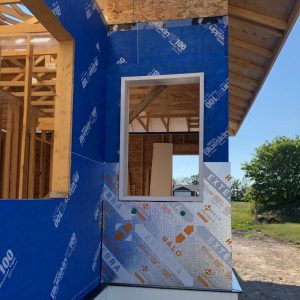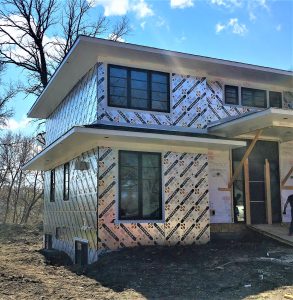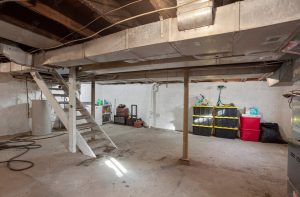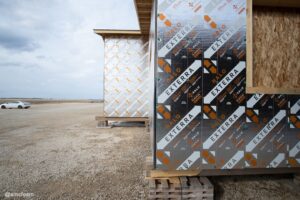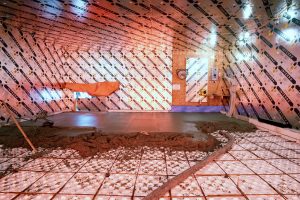Halo®’s rigid insulation products are a great fit for various residential uses, including:
- Under concrete slab
- Exterior below-grade concrete wall
- Exterior above-grade wood-framed wall
- Interior concrete wall
- Interior wood-framed wall
And did you know that in most cases, these boards are super-easy to install? This post will provide a quick summary of the installation and fastening requirements for these typical applications.
Under Concrete Slab
Halo’s Subterra series insulation is designed explicitly for under-slab applications. It’s laminated on both sides for extra jobsite durability, keeps away moisture, and provides R-5 per nominal inch. Subterra Plus even serves as a highly effective Radon barrier as well.
When you install Subterra under a slab, it’s vital to look out for protrusions that could damage the boards. To this end, be sure to check the compacted soil or granular material for any items that could penetrate the foam.
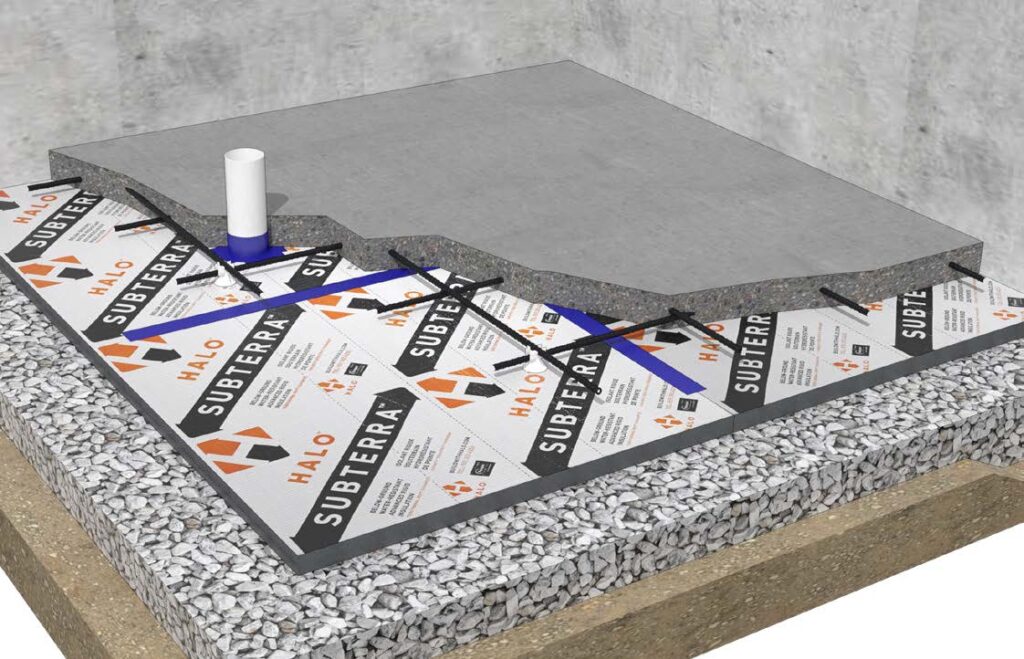
Once you’ve confirmed that the base surface is smooth and clear, simply lay down the Subterra boards — any orientation will do — and see to it that the panels abut each other tightly at their edges.
Finally, apply acoustic sealant between the Subterra boards and the footing and seal all joints with sheathing tape (those wider than ¼-inches should be filled with foam). Now you’re ready to pour the slab!
Exterior Below Grade Concrete Wall
Thanks to the polypropylene laminate on both sides of the foam core, Subterra offers stellar moisture-resistive properties that make it a perfect fit for below-grade concrete walls.
Before installing Subterra on a concrete wall, make sure that the waterproofing surface is smooth and, again, free of items that could damage the foam. If you’re insulating an existing wall, take the time to remove any backfill from the waterproofing film’s surface so that the panels fit flush to it.
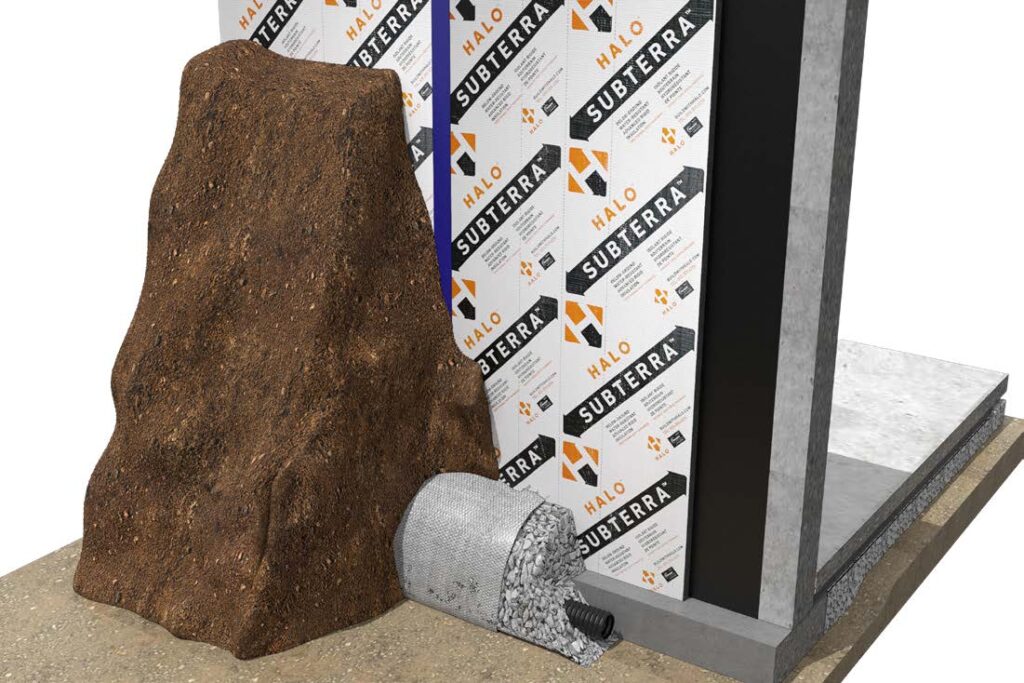
If you’ve managed to get the surface nice and even, simply use a weather-resistant glue, such as PL 300, to attach Subterra to the walls. On the other hand, if the concrete beneath the waterproofing membrane is too uneven, then you’ll have to use concrete screws and washers in conjunction with the adhesive.
Should you have to rely on screws, be sure to seal the penetrations with the same sheathing tape you’ll use to seal the joints between the Subterra boards. This step is crucial for maintaining Subterra’s moisture-resistance.
Likewise, you should use the sheathing or flashing tape to seal window and vent openings — this will prevent moisture from building up inside the wall assembly. In cold weather applications, you may have to use a water-based primer to ensure proper adhesion between the tape and the Subterra surface.
Once the insulation boards are fastened to the wall, taped, and sealed, you can go ahead and place the backfill.
Exterior Above Grade Wood-framed Wall
Halo’s Exterra® is water-resistive yet breathable — a unique property that stops vapor and build-up inside wall cavities and makes the product perfect for exterior applications.
If you’re applying Exterra to the sheathing, the fasteners you use should be long enough to completely penetrate the insulation board and the wood sheathing. The table below will help you to determine these lengths:

When installing Exterra over studs, the fasteners should penetrate at least ¾-inches into the studs or blocking. Here’s a table to help you find the correct fastener size:
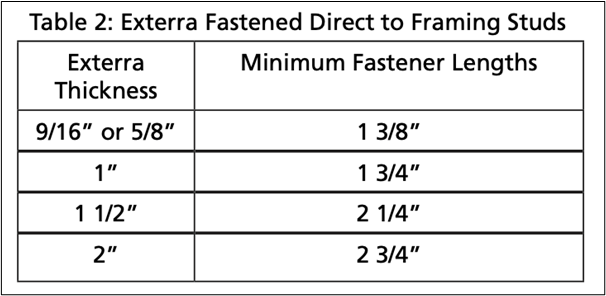
As long they meet the length and penetration requirements, you can use a wide variety of faster types, including:
- plastic cap nails
- roofing nails with at least ½-inch diameter washers
- cap staples
- wood screws with metal roof washers
Regardless of the fastener type and length, you can minimize their locations to the edges of the Exterra board corners — along with cladding and strapping, this will be enough to secure the boards in place.
Interior Concrete Wall
The Interra series has a built-in vapor barrier — a film applied to both sides of the foam core that can also reflect heat back into the home. Interra Plus can also be used in most US jurisdictions as an ignition barrier, so you don’t have to install drywall over it to meet the code. With these key features, Interra is tailor-made for interior applications.

Applying Interra panels to interior concrete walls — such as the walls of a basement — is a simple process, as long as the concrete surface is free of potentially damaging protrusions. If there’s nothing on the wall that could damage the Interra boards, simply secure them to the wall with an EPS-compatible glue, such as PL 300. If the concrete surface is too uneven, however, use concrete fasteners with washers alongside the glue. If you choose the latter option, seal the fastener penetrations in Interra with the same tape you’ll use on the joints — this will allow the boards to keep their vapor-resistant properties.
Interior Wood-framed Wall
You’ll need to use fasteners to install Interra to the interior face of a stud wall. The screws must be embedded at least ¾-inch into the stud, so please refer to the table to find the correct screw size:

To ensure that the Interra panels still serve as a vapor barrier, don’t forget to tape over the screw penetrations with the same tape you’ll use to seal the joints.
Wrapping It Up
Halo’s insulation products are well-suited for several common residential applications. They provide top thermal resistance values, durability, flexibility, and other characteristics that can make your structure more comfortable and energy-efficient. Best of all — these insulation boards are easy to install! Just make sure that you follow the correct fastening procedures we described in this quick guide.
Strategic Placement of House Wrap with Halo’s Exterra for Enhanced Building Protection
In 2024, optimizing your home’s insulation and moisture barrier strategies remains crucial, particularly when considering Halo’s Exterra as a pivotal component of your construction approach.
Comparing Halo Exterra by Logix Brands and Comfortboard 80 by Rockwool
Insulation plays a pivotal role in residential construction, affecting a building’s energy efficiency, safety, comfort, and environmental impact. The debate between Halo Exterra by Logix
Revolutionizing Basement Renovations: A Comprehensive Guide to Insulating and Flooring Your Existing Concrete Slab with Halo Interra
Transforming your basement is not just a home improvement project; it’s an investment in your property’s value and functionality. This guide focuses on basement finishing,

